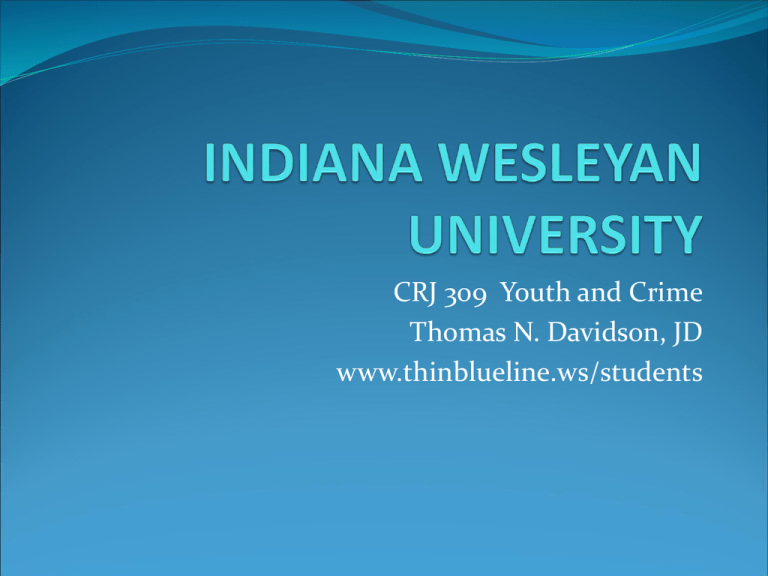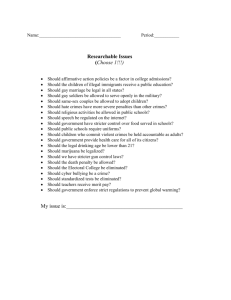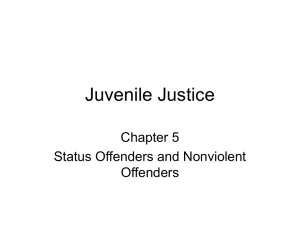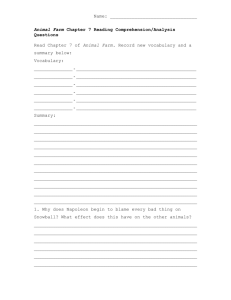indiana wesleyan university
advertisement

CRJ 309 Youth and Crime Thomas N. Davidson, JD www.thinblueline.ws/students Textbook Siegel, L. J., & Welsh, B. C. (2012). Juvenile delinquency: Theory, practice, and law (11th ed.). Belmont, CA: Wadsworth. Boys will be boys? Over and over again, the degree to which we accept violent or threatening behavior is dependent upon either the age of the perpetrator or whether a domestic relationship exists. A twelve-year-old who punches and kicks another twelve-year-old at the park might be dismissed as just “boys will be boys”. The frequent incidence of spousal, child, and domestic abuse in the United States has been well documented. What is the natural consequence of this violence? Karl Menninger once said, “What’s done to children, they will do to society.” Proverbs Contrary to the many other opinions, I believe the Bible was intended to instruct us in all areas of life. We do not find the concept of compartmentalizing one’s life into secular and religious realms. God has provided the principles for righteous living in all things (1 Peter 1:3). Still, in our American Democratic-Republic form of government, the government cannot dictate to us what to religion, if any, to follow. But, that does not mean that God and the Bible's teachings cannot influence our choices and decision making when confronting issues and problems in the criminal justice setting. I challenge you to incorporate faith in your learning experience anytime it is appropriate to do so. Proverbs is an interesting book on the surface, but it is not just another collection of ancient sayings. It is, rather, a collection of inspired truths in memorable and vivid forms. Proverbs covers a wide range of topics. There are proverbs concerning wealth, wisdom, friends, family, work, and worldliness. The Adolescent Dilemma 1980 nearly 80% of juveniles under the age of 17 were white, non-Hispanic. 1980 about 18% were black, non-Hispanic. 1980 about 11 % were Hispanic. 2010 about 58% were white. 2010 about 17% were black. 2010 about 22% were Hispanic 2010 about 3% were all other races. Ego Identity Ego identity is formed when youths develop a full sense of the self, combining how they see themselves and how they fit with others. Role diffusion Role diffusion occurs when people spread themselves too thin, experience personal uncertainty, and place themselves at the mercy of people who promise to give them a sense of identity they cannot develop for themselves. Example: Gangs. For a discussion on what factors increase the chances of gang activity among juveniles got to: http://www.lao.ca.gov/1995/050195_juv_crime/kkpart3 .aspx At Risk Youth Young people extremely vulnerable t the negative consequences of school failure, substance abuse, and early sexuality. Cynical & Preoccupied with Material Acquisitions By the time they reach 18, most young people have spent more time in front of the TV than in the classroom. They see thousands of depictions of rape, assault, murder, theft, and other anti-social behaviors. They also listen to hours of music with violent and sexual content. Research indicates that kids who listen to music with sexual content are more likely to engage in precocious sex than those who don’t. Each day in America: 2 mothers die in childbirth 4 children are killed by abuse or neglect 5 children or teens commit suicide 9 children or teens are killed by firearms 32 die from accidents 202 arrested for violent crimes 377 arrested for drug crimes 964 babies are born at low birthrate 1,210 babies are born to teen mothers Each day in America continued: 1,240 public school students corporally punished 2,060 babies born without health insurance 2,175 children are confirmed as abused or neglected 2,222 drop out of high school 2,692 babies are born into poverty 4,435 children are arrested 4,498 babies are born to unwed mothers 18,493 public school students are suspended from school Poor Education About 70% of all 4th graders cannot read at level About 90% of blacks About 80% of Latino About 80% of American Indian Black children are about 50% more likely to drop out of school than white children; in part caused by poor reading ability that leads to stress What is Juvenile Delinquency? Participation in illegal behavior by a minor who falls under a statutory age limit: IC 31-37-1-1 Delinquent child defined Sec. 1. A child is a delinquent child if, before becoming eighteen (18) years of age, the child commits a delinquent act described in this chapter. As added by P.L.1-1997, SEC.20. IC 31-37-1-2 Delinquent act Sec. 2. A child commits a delinquent act if, before becoming eighteen (18) years of age, the child commits an act that would be an offense if committed by an adult, except an act committed by a person over which the juvenile court lacks jurisdiction under IC 31-30-1. As added by P.L.1-1997, SEC.20 Ind. Constitution on Juvenile Delinquency Article IX, Section 2. The General Assembly shall provide institutions for the correction and reformation of juvenile offenders. (History: As Amended November 6, 1984). Chronic Delinquent Offenders Have been arrested four or more times Perpetuate the majority of serious juvenile crimes Do not “age out” of crime and continue criminal behavior in adulthood About 6% of offenders Aging-Out and Persistence Aging-out is the tendency for youths to reduce criminal activity as they grow older. Persistence is the process by which offenders persist in their delinquent careers instead of aging-out. Historic Perspective of Childhood Paternalistic family is a family where the father is the final authority Lower class children were expected to engage in adult roles as soon as physically able to work or learn a trade Children of nobility also entered adulthood early, but had greater opportunity for education. Girls were likely to be married off early in their teens. Primogeniture was the right during the middle ages of 1st born sons to inherit land and title. Male siblings had the option of the military or clergy. Dower system demanded that the family of a woman bestow land, money, or property to the man who would marry her. Swaddling was the practice of wrapping babies in cloth to restrict their movements and make them easier to manage. Historic Perspective of Childhood Poor laws (1535) allowed courts to appoint overseers over neglected and destitute children and allowing placement of these children in homes as servants Chancery courts created to oversee the lives of highborn minors who were orphaned or could not care for themselves Parens patriae means the power of the government to act on behalf of the child similar to that of a parent Child savers (19th Century) formed to develop programs and reforms. Best Interest of the Child Parens Patriae: A philosophical and legal viewpoint that encourages the state to take control of wayward children and provide care, custody, and treatment to remedy delinquent behavior. Status Offenses Conduct is only illegal because the offender is under age. Smoking and drinking Skipping school Runaway Participating in sex Curfew Profanity Disobeying parents Truantcy Part I Crimes Serious crimes against property and people Murder Rape Burglary Arson Motor vehicle theft Theft Aggravated assult Part II Crimes All other crimes that are not Part I crimes Public intoxication Driving under the influence Littering Disorderly conduct, et cetera Drug use What the data says More than 13.6 million arrests each year 2.3 million are Part I crimes 11 million are less serious Part II crimes Juveniles are arrested for approximately 15% of Part I violent crimes and 24% Part I property crimes Kids 14-17 account for only 6% of population, but are arrested for a disproportionate amount of crime. 1.1 million juvenile arrests in 2009 for Part II offenses 74,000 status offenses arrests in 2009 Time and Place Most delinquent acts occur in summer months of July & August Large urban areas have largest violent offender rates Rural areas have lowest violent offender rates Western & southern states have consistently higher rates of delinquency Gender and Delinquency Males significantly more delinquent (about 4 to 1 for violent crimes and 2 to 1 for property crimes) Girls more likely to runaway See Table 2.3 page 56. Race and Delinquency There are about 41 million white and 9 million African American youths from ages 5 to 17 (Ratio of 5 to 1) 70% of juveniles arrested are white; 28% African American (Ratio of 2.5 to 1) Disproportionate number of arrests between the races May be due to discrimination or that African American youths have a greater chance of being arrested. Racial Threat Theory – valid? Racial Profiling Causes of Delinquency Socioeconomic Status Theory Cognitive Behavior Theory Rational Choice Theory Trait Theory Biosocial Theory Psychological Theory Motives for Violent Delinquent Behavior Control – victim’s life Retribution – punish wrongdoer Deterrence – stop hostile or threatening acts Reputation – create self importance Crime Prevention& Deterrence Crime Prevention Crime Deterrence Likelihood Desire Ability Desire of being caught Opportunity Gravity of harm if caught Routine Activities Theory Capable Guardians Motivated Offenders Suitable Targets Figure 3.1 page 84.



